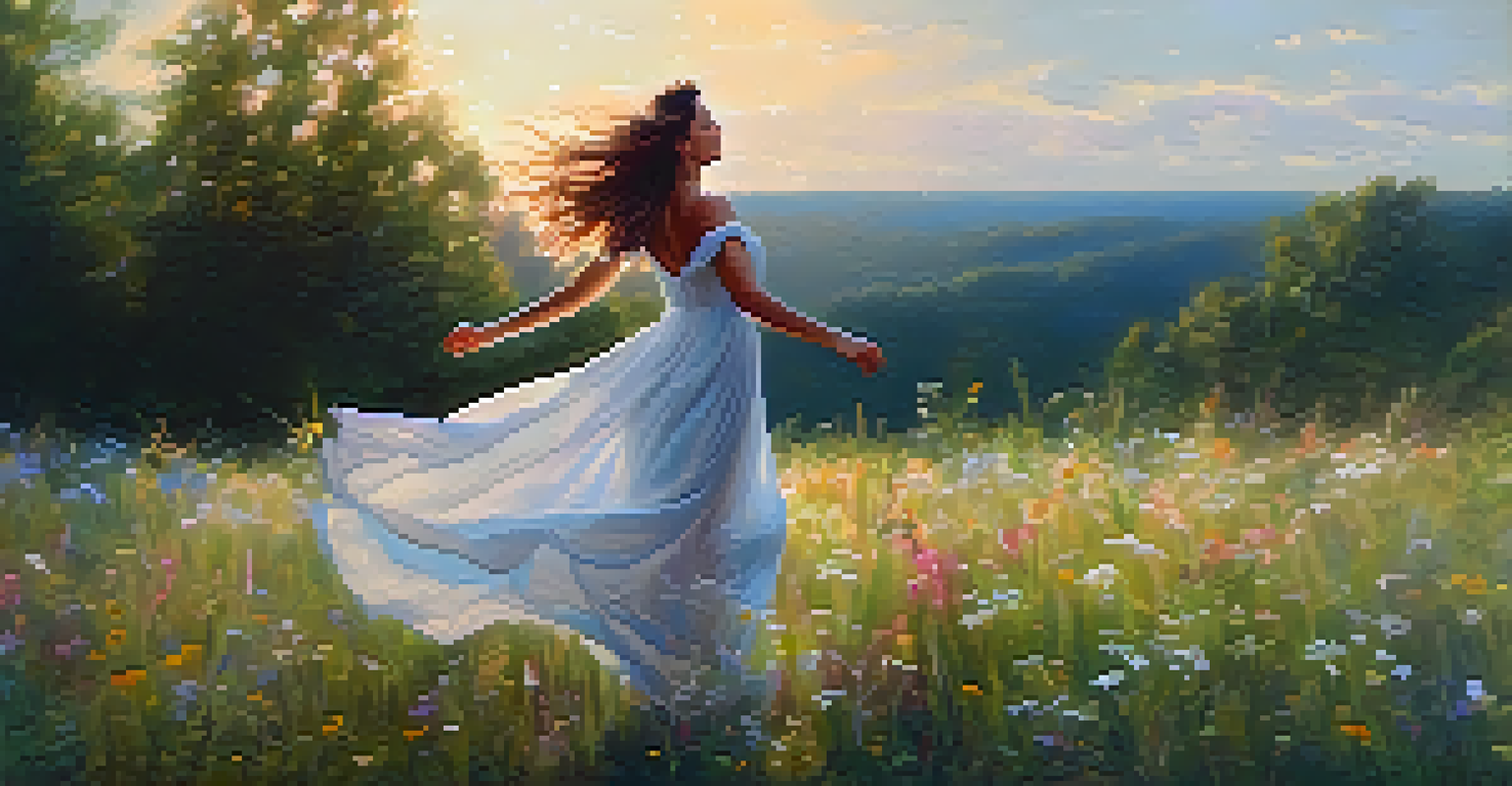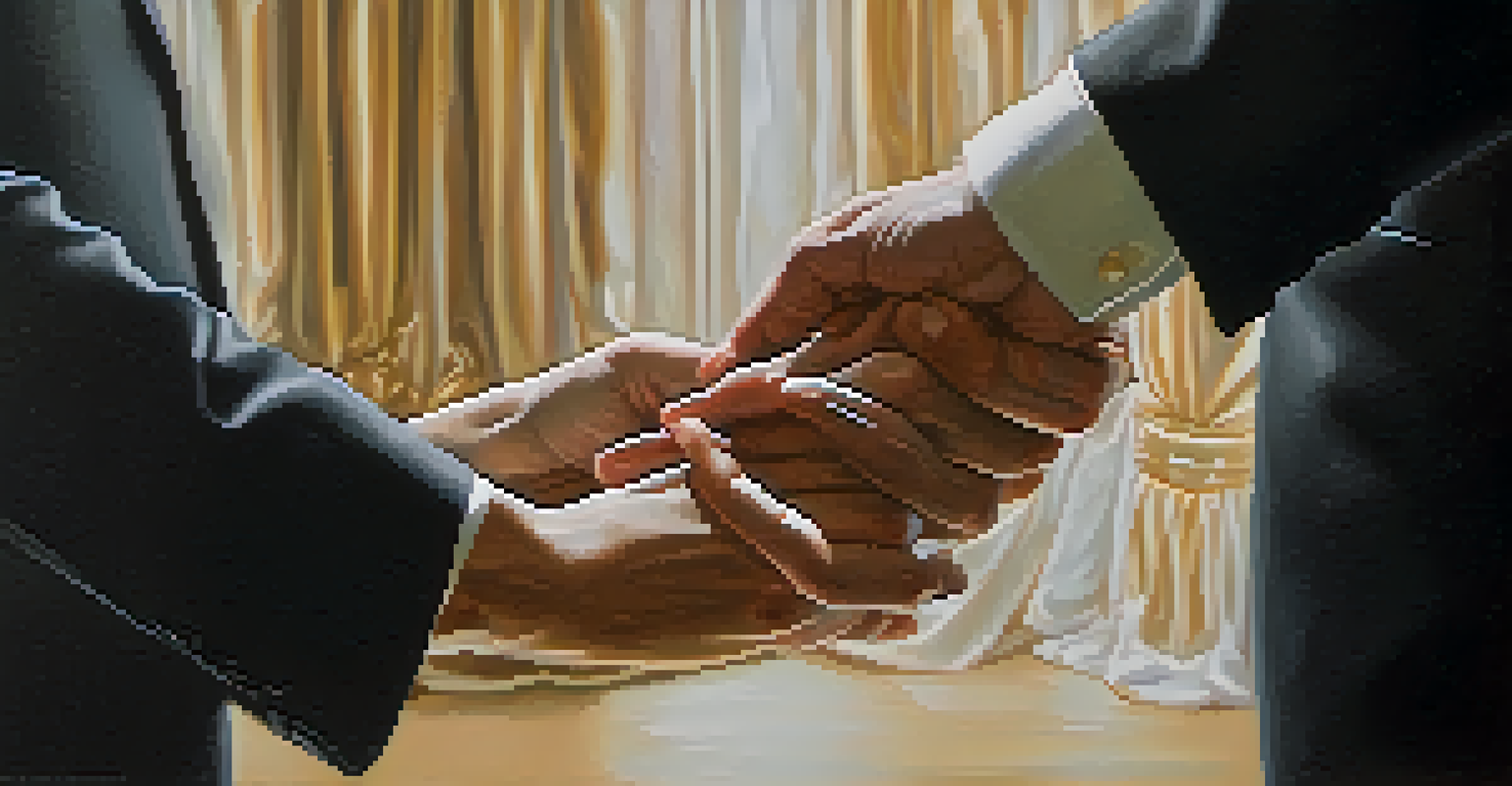Dancing with Words: Dance Imagery in 19th Century Novels

The Cultural Significance of Dance in the 19th Century
In the 19th century, dance was more than just a form of entertainment; it was a reflection of society's values and norms. Social dances, such as the waltz and the polka, often symbolized romance and courtship, making their way into the literature of the time. Authors used dance as a metaphor for social interactions, illustrating the complexities of relationships and societal expectations.
Dance is the hidden language of the soul.
For instance, in novels, dance scenes often set the stage for pivotal moments, revealing character dynamics and emotional undercurrents. A simple waltz could shift from joyful celebration to a tense confrontation, showcasing how movement can express what words cannot. This cultural backdrop allowed writers to infuse their narratives with deeper meaning, enriching the reader's experience.
Moreover, the popularity of dance during this era encouraged writers to explore its themes more deeply. Dance became a lens through which to examine issues like class disparity and gender roles, making it a powerful tool for social commentary. Thus, the imagery of dance became an integral part of the literary fabric, weaving together personal and societal narratives.
Dance as a Metaphor for Relationships
In many 19th-century novels, dance serves as a compelling metaphor for romantic relationships. Just as dancers must synchronize their movements, so too must couples navigate the complexities of love and intimacy. This parallel allows authors to explore the delicate balance of power and vulnerability inherent in relationships.

For example, in Jane Austen's works, dance scenes often highlight the social maneuvering required to secure a match. The intricacies of a partner's movements can mirror the subtleties of courtship, revealing intentions and emotions beneath the surface. Through these scenes, readers gain insight into the characters' personalities and the societal pressures they face.
Dance Reflects 19th-Century Values
In the 19th century, dance symbolized societal values, serving as a metaphor for relationships and social dynamics.
Additionally, dance imagery can evoke feelings of passion and conflict, illustrating the highs and lows of romantic entanglements. A dance that starts with harmony can quickly turn chaotic, much like relationships themselves. This dynamic representation allows readers to connect with the emotional depth of the characters, making their journeys relatable and poignant.
The Influence of Romanticism on Dance Imagery
The Romantic movement greatly influenced how dance was portrayed in literature, emphasizing emotion, individualism, and the sublime. Writers began to use dance as a means to express the ineffable feelings of love, loss, and longing that characterized the period. This shift allowed dance to become a powerful symbol of freedom and expression.
The dance is a poem of which each movement is a word.
In this context, dance scenes often reflect the inner turmoil of characters, capturing their struggles and desires. For instance, a character lost in a passionate dance may symbolize their yearning for freedom from societal constraints. The fluidity of movement becomes a metaphor for the complexity of human emotions, illustrating how dance can convey what words often fail to express.
Moreover, the Romantic celebration of nature and the human spirit found its way into dance imagery. Authors portrayed dance as a connection between the individual and the natural world, embodying the idea that movement is a form of self-expression. This interplay between dance and nature not only enriches the narrative but also deepens the reader's emotional engagement.
Dance Imagery in Notable Novels
Several 19th-century novels prominently feature dance imagery, highlighting its significance within the narrative. For instance, in Leo Tolstoy's 'Anna Karenina,' the ballroom scenes serve as a backdrop for the exploration of love and betrayal. The dance becomes a microcosm of society, illustrating the constraints and expectations placed on individuals.
Similarly, in 'The Age of Innocence' by Edith Wharton, dance scenes reveal the intricacies of social status and tradition. The carefully choreographed movements of characters at elite gatherings reflect their adherence to societal norms, while also hinting at their internal struggles. Through these vivid depictions, Wharton critiques the constraints of high society.
Dance as a Gender Commentary
Dance imagery in literature highlights the complexities of gender roles, illustrating both empowerment and societal constraints for women.
These examples demonstrate how dance imagery enriches the text, offering layers of meaning that resonate with readers. By embedding dance within the narrative, authors create a tangible connection between the characters' emotional lives and their social realities. This interplay invites readers to reflect on their own experiences and the role of dance in their lives.
Symbolism of Dance in Gender Roles
Dance imagery in 19th-century novels often highlights the complexities of gender roles and expectations. In many societies, dance was a realm where women could express themselves, yet it was also a space governed by strict societal norms. Authors skillfully navigated this duality, using dance to explore themes of empowerment and constraint.
For example, women in novels may find a sense of freedom and agency while dancing, only to be reminded of societal limitations once the music stops. This juxtaposition allows readers to engage with the ongoing struggle for autonomy faced by women during this period. The dance floor becomes a metaphorical battleground where personal desires clash with social expectations.
As a result, dance imagery serves as a powerful commentary on the evolving roles of women in society. It reflects the tension between tradition and change, illustrating how women navigated their identities within a patriarchal framework. Through this lens, readers can appreciate the nuanced portrayal of gender dynamics in 19th-century literature.
The Role of Dance in Character Development
Dance scenes often play a crucial role in character development, revealing hidden aspects of personalities and motivations. Through movement, characters express their emotions and desires, allowing readers to gain deeper insights into their inner lives. This dynamic representation can lead to significant character evolution throughout the narrative.
For instance, a hesitant dancer may symbolize a character's struggles with self-identity or social anxiety. As the story progresses, moments of confidence on the dance floor can signify personal growth and transformation. This progression not only enhances character arcs but also engages readers in the characters' journeys.
Legacy of Dance in Literature
The use of dance imagery in 19th-century novels has influenced contemporary literature, continuing to explore themes of emotion and identity.
Moreover, dance allows for the exploration of relationships between characters. By observing how individuals interact while dancing, readers can glean information about their connections and conflicts. This layer of complexity enriches the narrative, making the characters' experiences more relatable and impactful.
The Legacy of Dance Imagery in Literature
The use of dance imagery in 19th-century novels has left a lasting legacy in literature, influencing writers across generations. The ways in which authors incorporated dance into their narratives set a precedent for exploring themes of emotion, identity, and societal norms. This rich tradition continues to inspire modern writers who seek to convey complex ideas through movement.
Contemporary literature often revisits dance as a motif, reflecting on its historical significance while reinterpreting its meanings. Authors today may draw on the symbolism of dance to explore themes of freedom and constraint, echoing the sentiments of their 19th-century predecessors. This continuity highlights the timeless nature of dance as a vehicle for storytelling.

Ultimately, the legacy of dance imagery enriches our understanding of literature as a reflection of human experience. By examining how dance has been portrayed throughout history, we can appreciate the depth and complexity of the narratives that shape our cultural landscape. Dance remains a powerful metaphor, inviting readers to engage with the world in new and meaningful ways.